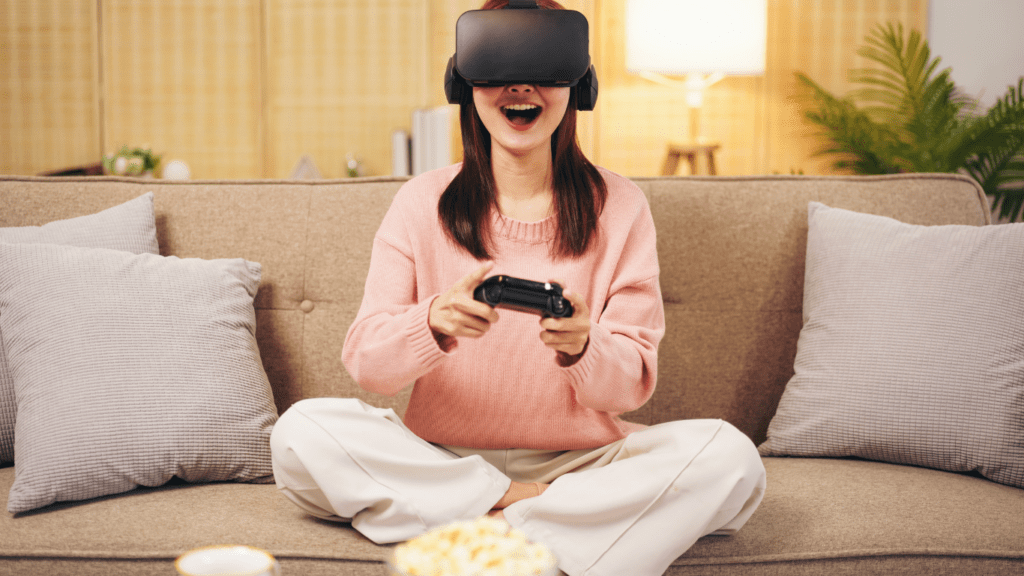The Evolution of Virtual Reality
Virtual Reality’s journey began in the 1960s with Morton Heilig’s “Sensorama.” This early VR device offered an immersive experience, combining 3D visuals, sound, and even smell. In the 1980s, Jaron Lanier coined the term “virtual reality” and founded VPL Research, which developed early VR equipment like the DataGlove and EyePhone.
In the 1990s, VR gained attention with NASA’s Virtual Environment Workstation Project and Sega’s attempt to create a VR headset for gaming. Both projects, however, faced technical limitations and did not achieve mainstream success. By the early 2000s, VR technology saw improvements with the advent of more sophisticated computer graphics and motion tracking.
The real breakthrough came in 2012 when Palmer Luckey launched the Oculus Rift on Kickstarter. This marked a significant step in VR’s evolution, making high-quality VR headsets more affordable and accessible. Tech giants like Sony, HTC, and Valve followed suit, releasing their own VR systems and further advancing the technology.
Today, VR has evolved into a robust platform with applications beyond gaming. Modern VR headsets offer high-resolution displays, advanced motion tracking, and wireless capabilities, enhancing user experiences. Industries such as:
- education
- healthcare
- real estate
- entertainment
now harness VR’s potential, showing how far the technology has come since its inception.
Virtual Reality in Gaming
Virtual Reality (VR) in gaming has seen vast advancements, transforming player interactions and experiences. VR’s progress in gaming technology offers immersive and realistic environments unlike traditional gaming setups.
Major Advancements
- Significant improvements in VR gaming include enhanced graphics, reduced latency, and better motion tracking.
- Modern VR headsets, like the Oculus Quest 2 and PlayStation VR, provide high-resolution displays and smooth gameplay.
- Motion controllers have evolved to capture accurate hand and body movements, further immersing players in virtual worlds.
- Developers use advanced haptic feedback and audio technology to create multisensory experiences.
- Haptic vests and gloves allow players to feel physical interactions, and 3D spatial audio amplifies the sense of presence.
Popular VR Games
Several VR games have gained popularity, attracting both casual and hardcore gamers. ‘Beat Saber’ challenges players to slash blocks to the rhythm of music, combining action and rhythm genres. ‘Half-Life: Alyx,’ regarded as a flagship VR title, offers a rich narrative and complex gameplay in a fully realized world. ‘The Walking Dead: Saints & Sinners’ immerses players in a survival horror experience, featuring realistic combat and decision-making mechanics. ‘No Man’s Sky’ VR allows players to explore an infinite universe, enhancing the original game’s exploration and discovery elements.
Impact on the Gaming Experience
VR fundamentally changes the gaming experience by enhancing immersion and player engagement. Players feel part of the game world, experiencing environments from a first-person perspective. Traditional barriers, like screens and controllers, dissolve in VR, creating a more natural interaction between players and game worlds. Physical activity in VR, as seen in fitness games, offers health benefits while ensuring an engaging experience. Social VR platforms enable players to meet, communicate, and collaborate, adding a community aspect to gaming. Overall, VR creates more memorable and impactful gaming experiences than traditional formats.
Beyond Gaming: Other Applications of VR

VR’s potential extends far beyond gaming, transforming various industries with its immersive experiences and practical applications. Here are some key sectors utilizing VR technology:
Healthcare
Healthcare professionals leverage VR for innovative solutions. Doctors use VR to simulate surgeries, enhancing their skills without risk to patients. Studies show that VR-based therapy effectively treats PTSD and anxiety disorders. VR also facilitates remote consultations, allowing for improved patient care regardless of location.
Education
Education benefits significantly from VR, offering immersive learning experiences. Students can explore historical events or scientific concepts in a virtual environment, enhancing understanding and retention. For instance, VR field trips allow students to visit places like the Great Wall of China or the International Space Station without leaving the classroom. VR also enables interactive training for complex subjects like chemistry and engineering.
Real Estate
Real estate agencies use VR for virtual tours, revolutionizing property viewing. Potential buyers can walk through homes remotely, saving time for both parties. This technology allows for better property visualization, helping clients make informed decisions. VR also aids in planning and interior design, providing a detailed preview of renovations or new builds.
Virtual Travel
VR has redefined travel by offering virtual tourism experiences. Users can explore exotic destinations, historical landmarks, and cultural events in a highly immersive way. This application is particularly beneficial for those with physical limitations or budget constraints. Virtual travel agencies and apps provide realistic experiences, making global travel accessible from home.
Challenges and Limitations
Despite its revolutionary potential, Virtual Reality (VR) faces several challenges that hinder its widespread adoption.
Technical Barriers
One of the major challenges VR technology faces is high hardware requirements. Modern VR headsets need powerful GPUs and processors, limiting accessibility for users with lower-end systems. Another technical limitation is the issue of latency. Even slight delays between the user’s movements and the VR environment’s response can lead to motion sickness. Furthermore, VR devices often require a wired connection to the computer, restricting user movement and detracting from the immersive experience. Developers also grapple with ensuring software compatibility across different VR platforms, which can be a significant hurdle.
Cost Concerns
Cost remains a significant barrier to VR adoption. High-quality VR headsets, like the Oculus Rift or HTC Vive, are expensive, with prices ranging from $300 to $1,000. Additionally, upgrading or purchasing a powerful computer to support VR can add to the total cost. Many potential users, including gamers and professionals, may find this cost prohibitive. Moreover, ongoing expenses for VR content, like games and applications, contribute to total expenditure, making it less accessible to casual users.
User Experience Issues
While VR offers immersive experiences, users often encounter issues like discomfort and motion sickness. Extended use of VR headsets can lead to physical discomfort, including eye strain and headaches. The bulky design of many headsets adds to this discomfort, making prolonged usage challenging. Additionally, VR’s steep learning curve can be a deterrent for new users, who may find the controls and navigation difficult to master. Social isolation is another concern, as VR experiences are often solitary, reducing real-world interactions during usage.
Addressing these challenges is crucial for VR technology to reach its full potential and achieve broader acceptance across various sectors.
The Future of Virtual Reality
The future of VR looks promising, with rapid advancements and increasing applications across diverse sectors. Innovations are continuously pushing the boundaries of what VR can achieve.
Upcoming Innovations
Several upcoming innovations promise to enhance VR experiences further. Hardware improvements focus on developing lighter, more comfortable headsets with higher resolution displays and improved field of view. Eye-tracking technology will offer more intuitive interactions and increase realism.
Haptic feedback systems are progressing quickly, allowing users to feel virtual textures and forces in a more immersive way. Developers are also working on full-body motion tracking, which will provide even more realistic experiences in virtual environments. Wireless technology, such as Wi-Fi 6E, will reduce latency and eliminate the need for cumbersome cables, improving user freedom and ease of use.
Potential Impact on Various Industries
The potential impact of these VR advancements spans various industries. In healthcare, VR will enhance surgical simulations, providing more precise training tools for medical professionals. It will also improve therapeutic treatments for mental health disorders, offering more personalized and effective interventions.
In education, VR will create more engaging and interactive learning environments. Students will experience virtual field trips and experiment simulations, making learning more dynamic and accessible. VR will also play a significant role in professional training, offering realistic simulations for fields such as aviation, manufacturing, and emergency response.
The real estate sector will further benefit from VR as virtual tours become more detailed and immersive, helping buyers make informed decisions without needing to visit properties physically. Additionally, VR will revolutionize architecture and design, allowing architects to walk through and modify their designs in a virtual space before construction begins.
In entertainment, VR will continue to transform gaming and film experiences, offering unprecedented immersion and interactivity. Social VR platforms will foster new ways for people to connect and interact, creating virtual communities and events that transcend geographical boundaries.


 Paulah Simmonserly, the visionary behind News Flip Network, has built a platform that delivers timely and comprehensive news across multiple fields. With a deep passion for journalism and a commitment to keeping the public informed, Simmonserly ensures the site covers everything from global affairs to business trends, health insights, and sports updates. Her leadership emphasizes accuracy and relevance, making News Flip Network a trusted resource for readers seeking up-to-date information on the events shaping the world.
Paulah Simmonserly, the visionary behind News Flip Network, has built a platform that delivers timely and comprehensive news across multiple fields. With a deep passion for journalism and a commitment to keeping the public informed, Simmonserly ensures the site covers everything from global affairs to business trends, health insights, and sports updates. Her leadership emphasizes accuracy and relevance, making News Flip Network a trusted resource for readers seeking up-to-date information on the events shaping the world.